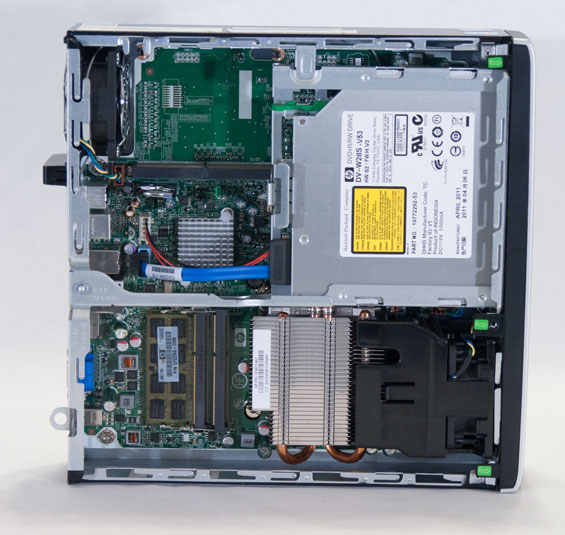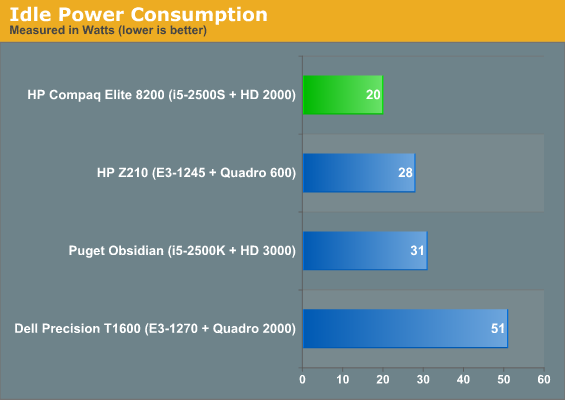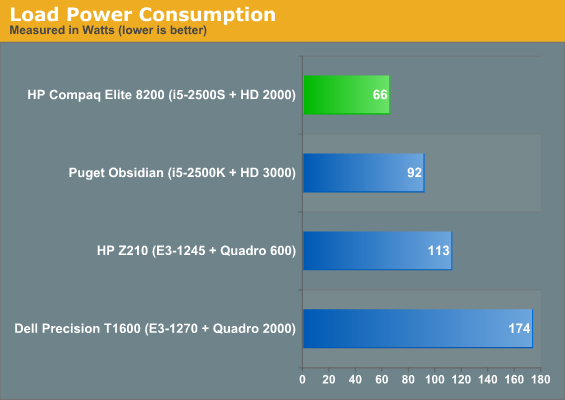HP Compaq 8200 Elite Ultra-Slim: The Littlest Desktop
by Dustin Sklavos on September 29, 2011 10:40 AM EST- Posted in
- Systems
- IT Computing
- HP
- SFF
- Enterprise
Build, Noise, Heat, and Power Consumption
Once again I have to state that I'm a big fan of how enterprise-class computers are built, specifically in regards to internal layout. Because these machines are designed to be easily serviced should the need arise, there are really quite a lot of intelligent ideas that go into how they're built that make me wonder why we don't see them more often on the consumer side. Take a look inside the wonderfully small HP Compaq 8200 Elite Ultra-Slim.

Everything is in its right place and extremely easy to service. Due to the smaller form factor, HP opts for mainly notebook parts inside the 8200 outside of the 65-watt processor. There's a substantial heatsink complete with copper heatpipes covering the processor, and a fan from the front channels air straight through it and out of the back of the case, cooling the memory in the process.
When I opened the 8200 the first time I was surprised to see the relatively large empty space in the top left corner; that MXM slot is actually there in case the system is custom ordered with a graphics upgrade, which can be cooled by the second small fan. The catch as noted earlier is that the only graphics upgrade available is an AMD Radeon HD 5450. Given the nature of this desktop, we can't say that upgrade is really worth it.

Considering the low power components of the 8200, it should come as no surprise that the system runs quietly and stays reasonably cool. The CPU temperatures aren't stellar (though they're still better than most notebooks we test), but this is also a very small enclosure, and HP has largely erred on the side of silence rather than performance. Since Sandy Bridge is already a cool-running architecture to begin with, this winds up being the right trade. Air circulation within the chassis also seems to be good enough to keep the 2.5" Western Digital Scorpio Black running cool.


Other than pure size, power consumption winds up being the 8200's trump card. With load power of just 66 watts, it's not hard to see why a business might want to deploy several of these for users who don't need extremely high-powered hardware. Idling at the desktop, it consumes a miserly 20 watts.














41 Comments
View All Comments
pandemicide - Thursday, September 29, 2011 - link
You are also forgetting a lot of businesses use Windows. Adding the cost of a windows licence to the mac mini plus the complications of setting up a OSX/Windows environment and getting techs that know both.JarredWalton - Thursday, September 29, 2011 - link
Nihility, it's not a $917 configuration, unless you're going to just go straight to HP and give them whatever they ask. The exact same system configuration is available elsewhere for $770:http://www.costcentral.com/proddetail/HP_Compaq_El...
So twice the processing power, more USB ports, twice the RAM, and three times the warranty (with onsite service). The best price I can find for the base Mac Mini is around $570 online. You can get an upgraded unit with 6630M graphics and a faster (but still dual-core) CPU, with 4GB RAM for $760. Still one-year warranty, though.
http://www.ecost.com/p/6842243?CAWELAID=944624666
And let's not forget serviceability. Anyone here ever tried opening a Mac Mini for servicing? It's not a trivial affair, and once inside the layout isn't ideal either. Long-term, I'd also be a lot more skeptical of the Mac Mini's ability to stay cool if you're running a more intense load, which leads to component failures and downtime.
Given the choice, I'd say anyone going with Mac Mini in a large deployment instead of something like this HP 8200 Ultra-Slim is worried to much about looking cool and being "hip" than they are with reliability, service, and support.
bgnoz - Thursday, September 29, 2011 - link
As a Mac mini user for years, I'd venture to say you haven't used one. The latest versions put this HP kludge to shame... they're wonderfully designed, fast, cool, low-power, and not at all difficult to service. Stupid simple for RAM, and not that bad for drives for anyone with build experience.I'm not hip or cool... the latest i7 mini is a great machine, and has replaced my towers (Mac, PC, and Hackintosh) for all but the heaviest video work. I'd love to see how they stack up against this HP parts bin machine.
JarredWalton - Friday, September 30, 2011 - link
How exactly does a Mac Mini "put this to shame"? It's a bit smaller, perhaps, but what else does it do better? Sure, the 6630M is an okay GPU, but most businesses don't care one way or the other because HD 2000 or HD 3000 is more than sufficient. Heck, I worked at a large company that had thousands of PCs across dozens of locations (I supported about 200 at my particular location), and they would have been happy to stick with older IGP hardware just to reduce the potential gaming capability -- people were periodically caught playing 6+ year old games, because even GMA 900 was fast enough to run stuff like Half-Life!So again, what does Mac Mini do better? It doesn't support higher spec CPUs like quad-core offerings. It doesn't come with an onsite 3-year warranty. It runs slower for the same price (because of a slower CPU and less RAM). HDD performance is probably a wash. Oh, and you need to either run OS X (95% or more of businesses don't), or you have to do Bootcamp. Either way, you're generally stuck going through Apple for Windows drivers, right? None of that would be good for a business PC.
ciparis - Friday, September 30, 2011 - link
Playing devil's advocate here...The one they call a server model is $999, and comes with a quad-core CPU, if the workload demands it. Business discounts are available.
Also, even if you're going to discount the GPU for whatever reason (which is becoming more and more relevant in day to day use) you have to recognize there is a desirable balance between GPU and CPU performance in a SFF design; the mini isn't a gamer, either, but it's a well-balanced design even with a dual core CPU, giving you very good general desktop performance with current OS's.
Re: Boot Camp: these are standard PC components, and while you can get a driver bundle from Apple (just like with HP) you can also source your drivers however you like (preferably from the component manufacturer).
Anyway, you probably wouldn't have had people kvetching about it if you'd at least mentioned the mini in passing, since it's such a similar concept, except much smaller and generally extremely well-executed (look at Anand's review, for example).
JarredWalton - Friday, September 30, 2011 - link
For a home user, the GPU in the Mac Mini is a definite plus (assuming you get the model that includes the GPU). For a business, like I said it really doesn't matter to 99% of the business owners -- unless you want your employees playing more games? HD 2000 is already "too fast" in terms of power for a lot of businesses to be happy, so now they have to worry about locking the PCs down tighter. It's not a big issue for large companies with IT departments, but for the smaller outfits I'd be curious to see how much time gets wasted playing games. Then again, Solitaire, Minesweeper, Flash games, etc. are all sucking down productivity.Since you mention the $999 server version, that actually doesn't have the GPU, though it does have HD 3000 graphics. As a home user, I'd say the middle-of-the-road model is the best option, providing a decent balance. For a business, again, I don't see any (good) reason someone would go for the Mac Mini over a business class ultra-slim desktop. Okay, that's not entirely true: two things the Mac Mini has that this doesn't are native HDMI, and ThunderBolt, and the built-in power supply might also be preferable in some circles. Not sure if the Mac PSU is as energy efficient, though.
owan - Thursday, September 29, 2011 - link
In what usage case that this PC targets is a mac mini going to be better? If you tried to suggest deploying mac minis in an enterprise setting you'd get laughed out of the building. "far higher build quality" isn't really true either. its got a shiny outer case, but this HP is a well designed piece of enterprise hardware.LoneWolf15 - Thursday, September 29, 2011 - link
I agree.It's not even the question of being laughed out of the building. It's that Apple, in the past decade, made modest inroads into enterprise markets --and then in the past 24 months, has deliberately burned every bridge they built.
With that kind of behavior, I wouldn't touch them in the enterprise. They're fine one-off machines that are miserable in large-scale environments.
Pessimism - Friday, September 30, 2011 - link
Apple Troll is trolling.Provide one shred of proof of your claim of "far higher build quality". They probably both came out of the same plant at Foxconn.
Peroxyde - Thursday, September 29, 2011 - link
I notice that modern computers use less and less the DVD player. In business scenarios, the system admin can always arrange so that people can get around without a DVD drive.